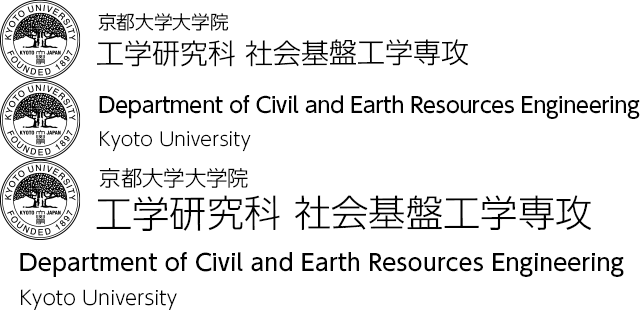Geomechanics
Geomaterials support all of the civil structures and environments as a ground. Therefore, we need to study the response of geomaterials to earthquakes, weathering, the changes of climate etc. accurately in order to build the civil structures and maintain environments safely. Furthermore, it is important to clarify the complicated soil-structure interaction and the mechanical behavior of structures. Our re-search activities focus deals on one hands with constitutive models for geomateials and on the other hand with the interaction between soil and structures through experiments and numerical analyses.
Academic Staff
Yosuke HIGO
 Professor (Graduate School of Engineering)
Professor (Graduate School of Engineering)
Research Topics
Geomaterials are multiphase mixtures of soil, water, air, and other materials, and their mechanical behavior is more complex than that of single-phase materials because it depends on the interaction between the phases. Therefore, we are investigating the relationship between the macroscopic deformation performance and strength properties of geomaterials by clarifying the structural changes of each phase from a microscopic viewpoint using X-ray CT technology. Furthermore, based on the physical background revealed by the experiments, we are developing a model that can precisely represent the deformation and fracture behavior of geomaterials, and developing a method to analyze and predict the deformation and fracture behavior of geomaterials under various external forces such as rainfall and earthquakes.
Contacts
Bldg. C1, Katsura Campus
TEL:
E-mail: higo.yohsuke.5z kyoto-u.ac.jp
kyoto-u.ac.jp
Ryota HASHIMOTO
Associate Professor (Graduate School of Engineering)
Research Topics
Main research targets are development of numerical methods and their application to the following geomechanics problems.
1. Seismic stability evaluation of jointed rock slope
2. Geotechnical conservation of historic masonry structures
3. Large deformation analysis of earth structures under interaction with fluids
4. Soil-construction machinery interaction problems
Contacts
Room 581, Bldg. C1, Katsura Campus
TEL: +81-75-383-3192
E-mail: hashimoto.ryota.6e kyoto-u.ac.jp
kyoto-u.ac.jp
Research Topics
Study on mechanical behavior of pile group foundation
Mechanical behavior of pile group foundation is different from behavior of the single pile multiplied pile number due to pile-ground-pile interaction that is called pile group effect, and it make the behavior complex. Clarification of the behavior has been studied by many researchers. From the knowledge, pile group effect of elastic range generated in static loaded small-matrix arranged group pile became to be estimated by using algebraic equation. However, in case pile constitution is different in pile group (e.g. additional pile method), in case of large-scale pile group (e.g. LNG tank foundation that is supported hundreds of piles), in case of seismic loaded pile group, mechanical behavior of pile group is not clarified enough.
In this study, centrifuge model test, in-situ loading test, 3D elasto-plastic finite element method etc. are used to clarify the mechanical behavior of these pile groups.
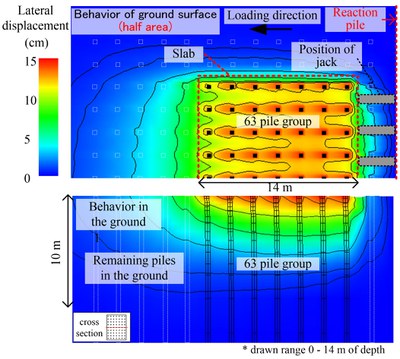
In-situ lateral loading test on 63 group pile and it’s FEM】
Seismic assessment of precast arch culvert
In the design of culverts in Japan, conventional culverts have been built over the past several years by applying methods which do not consider a seismic design. In recent years, however, opportunities for the construction of new types of culverts, which are outside the range of conventional culverts and are based on different design concepts, have been increasing. Representative of these culverts are precast arch culverts which include hinges in the main body. Precast arch culverts harness subgrade reactions positively by permitting deflection, and become mechanically stable structures. Therefore, compared with other forms which support external forces by the rigidity of the member, the thickness of the member is small and construction with a large section and a high overburden is possible. Furthermore, since the culvert is made from a precast product, there are advantages such as the saving of labor at the construction site, shorter work periods and high quality control. However, precast arch culverts have hinge functions on the main body, and thus, the conventional design method cannot be applied. Therefore, an evaluation of the seismic capacity of culverts and the dynamic interaction between the soil and the culverts has become an important issue.
In this laboratory, we research the seismic stability of precast arch culverts through the several experiments and numerical simulations.
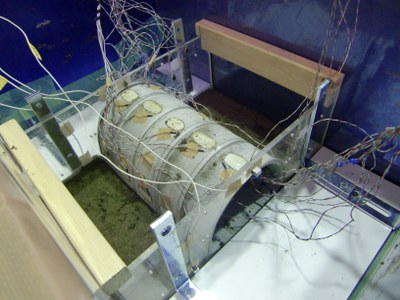
Dynamic Centrifuge Model Tests on Culvert Embankment with Perpendicular Wall in Culvert Longitudinal Direction
Development and Application of Reinforced Steel Chain Wall
Recently in Japan, a new method for fill reinforcement has been developed in which steel chain is used as inclu-sion. In this method, steel chain is integrated with steel made frame which act as wall facing. The advantages to use steel chain for the reinforcement of fill are; its flexibil-ity hence it can follow more effectively the deformation of soil and high pullout resistance than other reinforcing materials such as steel rods and steel bars. Furthermore steel chain is superior in workability and economic effi-ciency because it is lightness and easy to transport. We aim to identify the reinforcement mechanism and es-tablish economical technique of reinforced steel chain wall.
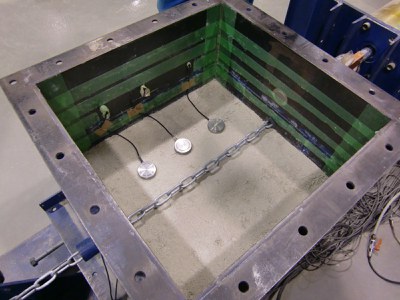
Pull out test of chain
Caracterization of geomaterials and the formulation of constitutive models
Focus is on the mechanical, hydraulic, and thermal properties of geomaterials, which have non-linear characteristics. For example, time-dependent behavior, degradation of soil structures, and anisotropy of natural deposits are modeled through laboratory tests under several loading conditions. In addition, strain-gradient dependency, instability of the material, and thermal-dependency on the mechanical behavior are taken into account in order to apply the model to the simulations for failure phenomena including the problem of strain localization, as previously mentioned. A liquefaction analysis requires an accurate cyclic model for sand and clay, which is useful under seismic loadings. A cyclic model for the ground which is improved by artificial materials, such as water glass for the prevention of liquefaction, is also studied for the seismic design.
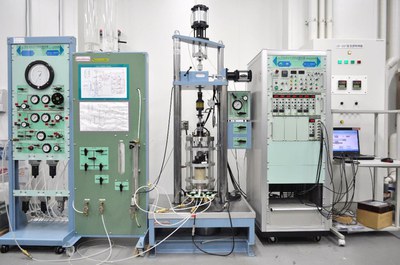
Hollow cylinder shear test apparatus available for several loading condition
Development of numerical methods to predict large displacement and failure phenomena precisely
Failure phenomena such as landslides and slope failure involve strain localization and the discontinuity of displacement. In addition, the localization of the compressive strain, that is, compaction bands, causes large settlement of the ground. Therefore, we need to investigate the mechanism of the localization of deformation, and develop an accurate analytical method in order to predict large deformations and failure phenomena, and prevent natural disasters. Experimental research includes triaxial compression tests with rectangular specimens of clay. We observe the failure process using image analysis so that the complicated failure phenomena with strain localization under three dimensional conditions can be precisely observed. Furthermore, the laboratory tests are simulated by means of large scale three dimensional finite element method based on soil-water coupling theory. We investigate the mechanism of strain localization, and then develop the analytical methods for the accurate prediction of the failure phenomena.
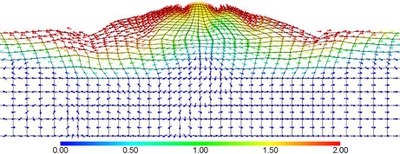

Dynamic simulation of river embankment(Displacement vector and distribution of shear strain
Development of high-efficient liquefaction analyses and making a hazard map
Liquefaction has been studied since public apartments were destroyed due to the 1964 Niigata earthquake. Liquefaction phenomenon was also observed at Port Island during the 1995 HyogokenNanbu earthquake. It is one of the most important geotechnical problems regarding to earthquake disasters. Since the recent trend of the seismic design method for soil structures is shifting to the performance-based design, the development of numerical methods to predict liquefaction is necessary for disaster prevention. We focus on the liquefaction analysis method based on the dynamic finite element method, in which equations of motion of fluid-solid mixture with the effective stress concept are adopted. We are developing highly-efficient analytical methods by which soil-structure interaction, large deformations of the liquefied ground and the relative acceleration of soil and water are taken into account. In addition, as measures to liquefaction soil improvement methods, such as chemical grouting, are investigated through both experiments and numerical analyses. Using a data base of ground information over a wide area, we are developing a hazard map by which we can evaluate the risk of liquefaction.
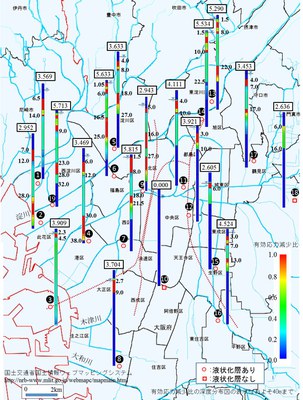
Liquefaction hazard map in Osaka city
Characterization for soils containing methane hydrate
Methane hydrate is being watched as a new energy for the next generation. It has been observed underneath the sea ground around Japan, and its constant production will bring us nationally produced energy resource. It is a possible resource for producing hydrogen for a fuel cell as well as for a natural gas. The production process is, however, still under development at present. The extraction of the gas may cause large compressive settlement, a landslide under sea flower, and big emission of the gas.
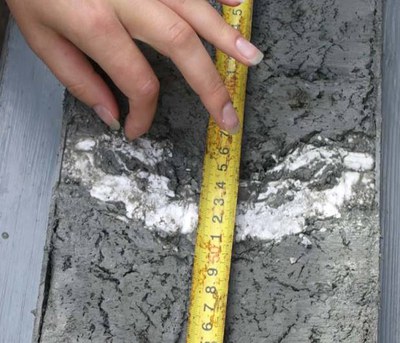
Gas hydrate bearing sedimentsobtained from Lake Baikal
Technical approach for poverty reduction in developing countries from geotechnical engineering view point
A lot of developing countries suffer from poverty caused by poor infrastructure such as a farm road or a pond in the rural area, nevertheless these countries make a living by agriculture. In the rainy season, unpaved roads are impassable due to muddy conditions.
To solve this problem, our team developed road maintenance method with using “Sac” based on the policy that local people should solve the problem of developing country with simple method suitable for local site. Now our activities are expanding into various countries.
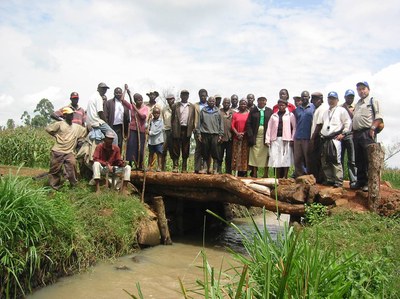
Maintenance of rural access roads using“Do-nou” technology
